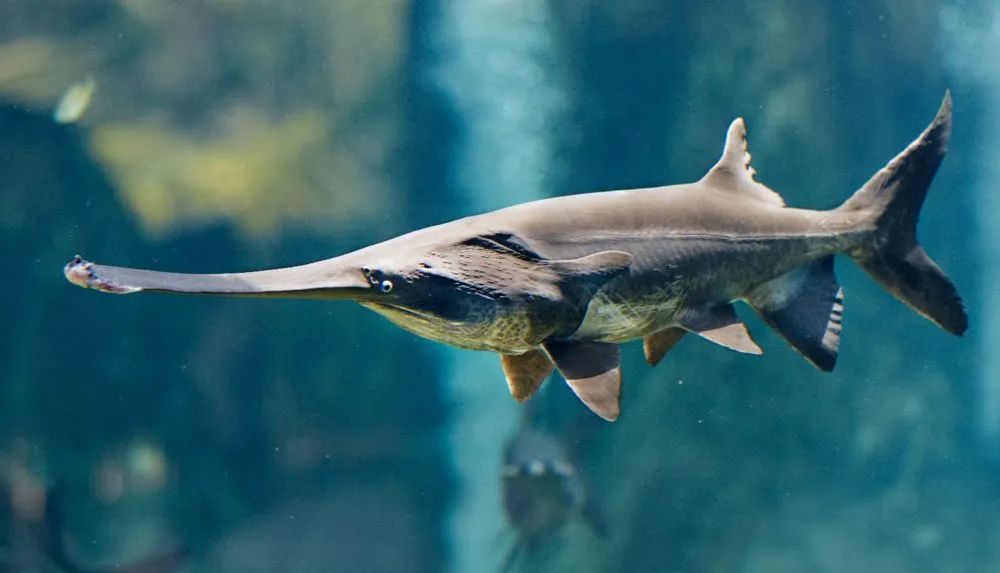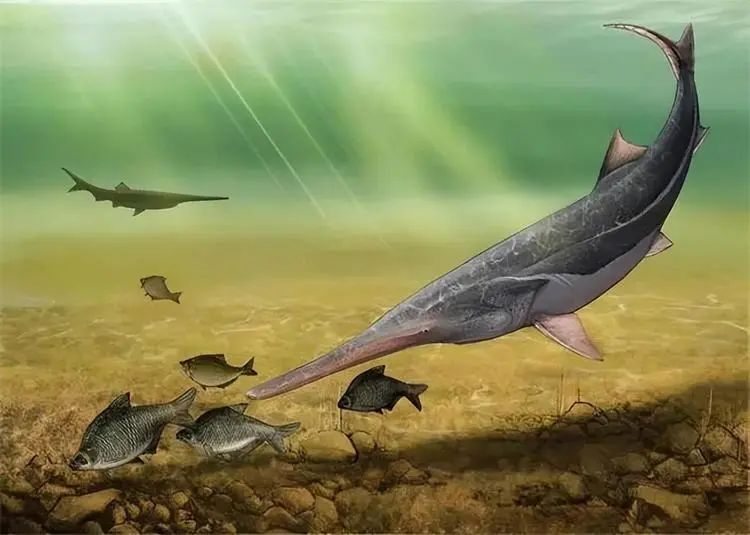Chasing traces in the pen and ink
Author:China Water Transport News Time:2022.08.07
On July 21, the International Nature and Natural Resources Protection Alliance (IUCN) released a distressing news. The global endangered species red catalog update report announced that the White River is extinct, the Yangtze River is extinct, and the naked belly is extinct.
Now the white puppet disappears, but they will always live in the ancient pen and ink.

Bai Yan in classical
The Yangtze River Baiji, also known as Xiangbi, piano fish, and dynasty swordfish, was also called 鲔 in ancient times. During the Spring and Autumn Period, "The Book of Songs · Zhou Song" had poems: "猗 and lacquer are frightened, there are too many fish. Both 用 and 都 carp are used to sacrifice and find well -being. And 鲔 is the white 是.
"Book of Rites" records, "The emperor began to take the boat, recommended in the bed temple ... The fish products are many, and the recommended will be the same as the big one." The big white magpie is a special supply product, sacrificed to the ancestors and ghosts to bless the coming year. It can be seen that the earliest time, the catfish mostly used to sacrifice, which shows its preciousness.
For catfish, Wu Luji of the Three Kingdoms explained in "Mao Shi Poems, Birds and Beasts, Birds and Beasts, Worm Fish Shu Shu": "Curma, blue and black, small and sharp head, like iron pockets, the mouth is under the cricket, and the nail can Ginger, the big one is only seven or eight feet.
In ancient times, catfish was also known as catfish. The famous Eastern Han Dynasty scientist Ma Rong not only explained elegance, essence nuclear, but also good rhythm, drum piano played a flute, and once wrote "Flute Fu". Dausheng, "The catfish is in the water, and the horses are dancing."
In "Huainanzi", there are also records that "Baga drum piano, catfish listen." Later, "Huainanzi" also wrote "catfish" as "kinky fish". The head and body are half -shaped, the long -bodies are white, the nose is white, the body is black, the mouth is under the jaw, it looks like a jailfish, and there is no scales of fish, out of the river. " The mouth is in line, so "On the Heng" is used as catfish.
"Shu Du Fu" by the Jin Dynasty writer Zuo Si also wrote, "Blowing hole flutes, sendsing crickets, feeling catfish, and moving Yanghou." Western Jin Liu Yan explained: "Matsters, out of the river, head and body are right and body. Half, the mouth is under the abdomen. "Qing Li Yuan's" Cynefly · Title "also records," Qinhuang fish, five or six feet long, the belly and stomach have a lapse of the knife, out of the East China Sea, and the same name as the same name as the catfish, the same name as the same name as the same name as the same name . "The catfish in these celebrities also refers to catfish.
Bai Yan is mainly distributed in the dry branches of the Yangtze River from Yibin to the Yangtze River in my country. The Qiantang River and the Yellow River have also been discovered, and the river lay back in the spring. The white 鲟 body is shuttle -shaped, the front of the front is slightly flat, the middle section is thick, and the back is slightly flat. The head is very long, the head is more than half the length of the body, and it has plum blossoms. Kiss's head and abdomen can be freely stretched. The ancient book has the record of "the mouth of the mouth is under the jaw, and the long nasal cartilage", which summarizes the ecological characteristics of Bai Yan. There are small teeth on the upper and lower jaws of the white ravioli; a pair of kisses, short, located on the abdomen. The eyes are small, there is a small pair, located on the belly of the kiss. Large mouth cracks, curved, telescopic, located on the head of the head. The head, body back and tail fin are blue and gray, with white abdomen.
The "迹" trace of the literati pen
There are many types of catfish. In addition to the white lame, Chinese crickets in the Yangtze River, and a spoon of kiss, their kisses have long swords, narrow and flat front end, thick base, distributed in the dry flow of the Yangtze River. Can reach the Fenwei Basin.
As the saying goes: "Jack of library, 10,000 jacks." Jacks of library refer to Chinese crickets, and "Wan Jian Xiang" refers to white 鲟. The largest individual of white ravioli can reach 7 meters and weigh 908 kg, which is included in the "ten largest freshwater fish in the world".
In the Song Dynasty, the catfish frequently appeared in the vision of the literati. The poet Su Shi had a poem "The Fish Fish (in the County)", which wrote: Sword of the sword. The purple magpie wore the cheek miserable, and the red scales were sitting light. Although it was still moving, it was still dyeing before cooking. Taste the year of the same year, and the yellow croaker has repeatedly eaten the sand head shop. Binjiang is easy to use, and the ruler is abandoned. "
Among them, "long fish is like a sword", which is written in Bai Yan, because Bai Yan's kiss is like a long sword. The yellow croaker written later refers to the Chinese pupa in the Yangtze River. "Early years of age are Jing Zhu, yellow croaker has repeatedly eaten Shatou shops." Su Shi in the four years of Jiayou (1059) winter, his father Su Xun and his brother Su Zhe went out of the Three Gorges from Meizhou, taking Tao Jingsha and Xiangyang. When Liang, when Jingsha stayed, it was the period when China traced the river. In the period when the spawning of the Jinsha River, Su Shi ate this fish many times in Jingsha, which is the huge and precious Chinese cricket.
Lu You, a great poet in the Southern Song Dynasty, was appointed by the imperial court for five years (1170). When he was sentenced to the Yangtze River in the Yangtze River, he wrote the famous long diary "Ji Shu Ji". Record I see the catfish in the Yangtze River twice.
Lu You was in Haigen Port (now the name of the Jiang section of Guichi County, Anhui) near Jiuhua Mountain. The waves are really spectacular. "According to Lu You's records, the" giant fish "in it refers to the Chinese magpie, because the maximum body length of the Chinese cricket can reach more than seven or eight meters long, blue yellow, white belly, it is indeed like the Lu Youxin seeing the location of the Lu Youxin. The "yellow calf". This is a scientific name in modern times. In ancient times, it was not called Chinese 鲟, and its local names were quite common, such as yellow croaker, big masaki, jade version of fish, and light fish. The Jin Dynasty Guo Yan once note the "Erya": "Well, big fish, like a cricket and short nose, under the forehead, the body has evil sidewalks, no scales, yellow meat, two or three feet long. Jiangdong Huhuo is a yellow croaker. "After Lu You left Ezhou," Xie Jiaji, Golden Rooster ... There are settlements in the crickets, such as small counties. Out of catfish, resident rate is sold for the karma. "Lu You saw catfish twice. It can be seen that the Yangtze River China Capital in the Song Dynasty was already very common. According to Lu Ji's "Mao Poetry, Poem, Bird Beast · Worm Fish Shu Shu", this kind of catfish is like a dragon, with more than a thousand pounds of large, meat can be steamed as meat custard, and caviar can be sauce. Therefore, Lu You saw that the local people used to capture catfish and make caviar.
It is regarded as a treasure from ancient times to the present
Like Chinese crickets, the individual is large, the meat is fresh, and it is rich in fat and high protein. It is because of its rich nutrition that it has always been regarded as a consumption of treasures. Jiangsu and Shanghai have listed 鲥, gun (white 鲟), 鮠 and Jia (Chinese 鲟) as four famous fish. In addition, the medicinal value of Bai Yan and Chinese 用 is also very high.
Ming medicalist Li Shizhen has a special record for catfish, with the "Compendium of Materia Medica · Scale Four · Baoya" special bar, which says: "Its shape is like a pupa and has no nails on the back. Its nose is long and body, and the mouth is under the jaw, and the food does not drink. There are green spotted patterns under the cheeks, such as plum blossoms, tails are like C. The meat is pure white.
The poet Wang Shizhen of the Qing Dynasty once went down the river and traveled to the Three Gorges to see the custom of catching catfish in the local area. He wrote in one of the "Xiling Bamboo Branch": Township. The setting sun on the river is late, and Bai Pinghua is always selling. "This" 枋 "is the fish grid appliance of fishing. The Chinese 鲟 traces the Xiling Gorge in the end of the autumn and early winter. The eggs, and then down the river, the season when the white apples bloom were a good time to catch catfish.
The writer Luo Hong in the Qing Dynasty also mentioned this phenomenon. It was common for catcher to eat catfish and make caviar, indicating that the catfish at that time was very common and easy to capture.
The image of the ancient white ravioli also often appears in the portrait stone and painting. It portrays a white cricket on the portrait stone of the Chengdu Museum, which is realistic, especially the pointed and long nose. This proves that in the Han Dynasty, the local people were very familiar with this long nose strange fish. The Jinsha site that was unearthed from more than 3,000 years also had two gold bands that portrayed fish patterns, long kisses, and the front end was tilted upwards. It was an exaggerated image.
The painter of the Ming Dynasty was solemnly, a native of Yixian County, Anhui. He lived in Nanjing for a long time. He has a famous painting called "Sou Shan Map". Among them, he vividly draws the image of Bai Yan, because he is a person from the Yangtze River. To the white magpie in the river, so I can vividly draw the white cricket statue.
The first photo of the existing Bai Yan was taken by John Thomson, a foreigner John Thomson in the tenth year of Qing Tongzhi (1871). In March 1994, my country issued the Yangtze River Baiji Memorial Stamp. A set of four, the largest ticket was 50 points. This shows that 28 years ago, Bai Yan was still common in my country.
Final appearance
On January 24, 2003, the last time people saw Bai Yan in Yibin, Sichuan. This white puppet was arrested by a fisherman Liu Longhua at a chaotic stone in the mouth of the Yangtze River. Bai Yan, who was in the fishing net, was frightened and raised around.

At that time, the staff of the Yibin Aquatic Fisheries Bureau rushed to the scene immediately after hearing it. When I saw that the three -meter -long Bai Yan was like a cow, she was put next to the fishing boat. There was a 20 cm long wound on the head. Essence They immediately reported to the Yangtze River Aquatic Research Institute to assist experts from Wuhan to carry out rescue work. After a series of medical treatment, the fourth day of Bai Yan had resumed the spirit, and the experts put it back to the Yangtze River.
For scientific research needs, they installed sons tracking on this white -ray fins, and began to have signals, and then disappeared without a trace.
Since 1983, my country has banned commercial fishing. At the same time, in order to solve the problem of unproducting China, the China Institute of Gezhouba Group has implemented manual reproduction and release from the year. In 1989, the Yangtze River Baiji and Zhonghua Po were listed as a national key protection wildlife. In 2002, the downstream area of the Yangtze River began a three -month -old fishing period forbidden. On January 1, 2021, the key waters of the Yangtze River Basin officially entered the ten -year fishing period. In the same year, policies and laws such as the "People's Republic of China The Yangtze River Protection Law" and "Regulations on the Management of Aquatic Biological Protection of the Yangtze River" were successively introduced.
my country has achieved results since its implementation. In November 2021, the preliminary monitoring results released by the "Yangtze River Ecological Protection and Fisheries Development Forum" in the 5th China Modern Fisheries and Fisheries Science and Technology Expo in November 2021 showed that the common fish resources of the Yangtze River resumed The trend of the Yangtze River ecological environment shows signs of recovery of threatening fish population.In the past, Bai Yan, as a unique species of the Yangtze River, is one of the very few ancient fish that was survived by Bai Yanpai, which was 150 million years ago, and belonged to the national first -class protection of wild animals.Human beings must do their best to maintain the safety of wild fish in the Yangtze River, otherwise, in the future, we can only shuttle in the text and paintings of literati.
Source: China Water Transport News
Author: Liu Yongga
Responsible editor: Zou Yuxuan
Review: Hongbo
not

- END -
Theme reading, Chinese lecture hall, interesting baking ... Caring for children's growth Li Cang is in action

In order to guide children in the jurisdiction to promote the mainstream values ...
The third case of the hematopoietic stem cell donor of the Qianxianqianqi Banner successfully donated the return
